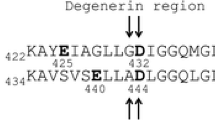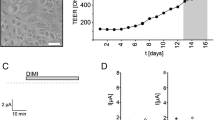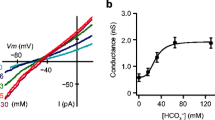Abstract
Despite the identification of cholangiocytes in the liver and unipolar brush cells in the cerebellum as sites of expression, the physiological function of the bile acid-sensitive ion channel (BASIC) remains unknown. Rat BASIC (rBASIC) and mouse BASIC (mBASIC) share 97% of their amino acid sequence but show strikingly different biophysical properties. rBASIC is inactive at rest while mBASIC is constitutively active, when expressed in Xenopus oocytes. This conundrum rendered the identification of the physiological function even more difficult. In this study, we investigated the electrophysiological and pharmacological properties of BASIC from rat, mouse, and human in Hek293 cells using the patch clamp technique. Surprisingly, in Hek293 cells, rBASIC and mBASIC showed almost completely identical properties. Both are blocked by extracellular Ca2+ and thus are inactive at rest; both are selective for Na+, show similar affinities for extracellular Ca2+, were inhibited by diminazene, and activated by various bile acids. This is in contrast to previous results derived from Xenopus oocytes as expression system and suggests that the cell type is important for shaping the biophysical properties of BASIC. Furthermore, we compared hBASIC with rBASIC and mBASIC and observed similar properties between these channels with one exception: the bile acid sensitivity profile of hBASIC is different from rBASIC and mBASIC; hBASIC is more sensitive to bile acids which are abundant in human bile but not in rodent bile. Taken together, these results suggest similar physiological roles for BASIC in different species.







Similar content being viewed by others
Abbreviations
- ASIC:
-
Acid-sensing ion channel
- BASIC:
-
Bile acid-sensitive ion channel
- CA:
-
Cholic acid
- CDCA:
-
Chenodeoxycholic acid
- DCA:
-
Deoxycholic acid
- ENaC:
-
Epithelial Na+ channel
- HDCA:
-
Hyodeoxycholic acid
- LCA:
-
Lithocholic acid
- UDCA:
-
Ursodeoxycholic acid
References
Assmann M, Kuhn A, Dürrnagel S, Holstein TW, Gründer S (2014) The comprehensive analysis of DEG/ENaC subunits in Hydra reveals a large variety of peptide-gated channels, potentially involved in neuromuscular transmission. BMC Biol 12:84. https://doi.org/10.1186/s12915-014-0084-2
Bianchi L (2007) Mechanotransduction: touch and feel at the molecular level as modeled in Caenorhabditis elegans. Mol Neurobiol 36:254–271. https://doi.org/10.1007/s12035-007-8009-5
Boiko N, Kucher V, Wang B, Stockand JD (2014) Restrictive expression of acid-sensing ion channel 5 (asic5) in unipolar brush cells of the vestibulocerebellum. PLoS One 9:e91326. https://doi.org/10.1371/journal.pone.0091326
Canessa CM, Schild L, Buell G, Thorens B, Gautschi I, Horisberger JD, Rossier BC (1994) Amiloride-sensitive epithelial Na+ channel is made of three homologous subunits. Nature 367:463–467. https://doi.org/10.1038/367463a0
Chen X, Qiu L, Li M, Durrnagel S, Orser BA, Xiong ZG, MacDonald JF (2010) Diarylamidines: high potency inhibitors of acid-sensing ion channels. Neuropharmacology 58:1045–1053. https://doi.org/10.1016/j.neuropharm.2010.01.011
Driscoll M, Chalfie M (1991) The mec-4 gene is a member of a family of Caenorhabditis elegans genes that can mutate to induce neuronal degeneration. Nature 349:588–593. https://doi.org/10.1038/349588a0
Dürrnagel S, Kuhn A, Tsiairis CD, Williamson M, Kalbacher H, Grimmelikhuijzen CJ, Holstein TW, Gründer S (2010) Three homologous subunits form a high affinity peptide-gated ion channel in Hydra. J Biol Chem 285:11958–11965. https://doi.org/10.1074/jbc.M109.059998
Fisher MM, Yousef IM (1973) Sex differences in the bile acid composition of human bile: studies in patients with and without gallstones. Can Med Assoc J 109:190–193
Ilyaskin AV, Diakov A, Korbmacher C, Haerteis S (2016) Activation of the human epithelial sodium channel (ENaC) by bile acids involves the degenerin site. J Biol Chem 291:19835–19847. https://doi.org/10.1074/jbc.M116.726471
Ilyaskin AV, Diakov A, Korbmacher C, Haerteis S (2017) Bile acids potentiate proton-activated currents in Xenopus laevis oocytes expressing human acid-sensing ion channel (ASIC1a). Physiol Rep 5. https://doi.org/10.14814/phy2.13132
Ilyaskin AV, Kirsch SA, Bockmann RA, Sticht H, Korbmacher C, Haerteis S, Diakov A (2018) The degenerin region of the human bile acid-sensitive ion channel (BASIC) is involved in channel inhibition by calcium and activation by bile acids. Pflugers Arch 470:1087–1102. https://doi.org/10.1007/s00424-018-2142-z
Jasti J, Furukawa H, Gonzales EB, Gouaux E (2007) Structure of acid-sensing ion channel 1 at 1.9 A resolution and low pH. Nature 449:316–323. https://doi.org/10.1038/nature06163
Kellenberger S, Schild L (2002) Epithelial sodium channel/degenerin family of ion channels: a variety of functions for a shared structure. Physiol Rev 82:735–767. https://doi.org/10.1152/physrev.00007.2002
Kellenberger S, Schild L (2015) International Union of Basic and Clinical Pharmacology. XCI. Structure, function, and pharmacology of acid-sensing ion channels and the epithelial Na+ channel. Pharmacol Rev 67:1–35. https://doi.org/10.1124/pr.114.009225
Lefevre CM, Diakov A, Haerteis S, Korbmacher C, Gründer S, Wiemuth D (2013) Pharmacological and electrophysiological characterization of the human bile acid-sensitive ion channel (hBASIC). Pflugers Archiv 466:253–263. https://doi.org/10.1007/s00424-013-1310-4
Lingueglia E, Champigny G, Lazdunski M, Barbry P (1995) Cloning of the amiloride-sensitive FMRFamide peptide-gated sodium channel. Nature 378:730–733. https://doi.org/10.1038/378730a0
Sakai H, Lingueglia E, Champigny G, Mattei MG, Lazdunski M (1999) Cloning and functional expression of a novel degenerin-like Na+ channel gene in mammals. J Physiol 519(Pt 2):323–333
Sakakura H, Suzuki M, Kimura N, Takeda H, Nagata S, Maeda M (1993) Simultaneous determination of bile acids in rat bile and serum by high-performance liquid chromatography. J Chromatogr 621:123–131
Schaefer L, Sakai H, Mattei M, Lazdunski M, Lingueglia E (2000) Molecular cloning, functional expression and chromosomal localization of an amiloride-sensitive Na(+) channel from human small intestine. FEBS Lett 471:205–210. https://doi.org/10.1016/S0014-5793(00)01403-4
Schmidt A, Lenzig P, Oslender-Bujotzek A, Kusch J, Lucas SD, Gründer S, Wiemuth D (2014) The bile acid-sensitive ion channel (BASIC) is activated by alterations of its membrane environment. PLoS One 9:e111549. https://doi.org/10.1371/journal.pone.0111549
Schmidt A, Löhrer D, Alsop RJ, Lenzig P, Oslender-Bujotzek A, Wirtz M, Rheinstadter MC, Gründer S, Wiemuth D (2016) A cytosolic amphiphilic alpha-helix controls the activity of the bile acid-sensitive ion channel (BASIC). J Biol Chem 291:24551–24565. https://doi.org/10.1074/jbc.M116.756437
Schmidt A, Rossetti G, Joussen S, Grunder S (2017) Diminazene is a slow pore blocker of acid-sensing ion channel 1a (ASIC1a). Mol Pharmacol 92:665–675. https://doi.org/10.1124/mol.117.110064
Setchell KD, Rodrigues CM, Clerici C, Solinas A, Morelli A, Gartung C, Boyer J (1997) Bile acid concentrations in human and rat liver tissue and in hepatocyte nuclei. Gastroenterology 112:226–235. https://doi.org/10.1016/S0016-5085(97)70239-7
Wemmie JA, Taugher RJ, Kreple CJ (2013) Acid-sensing ion channels in pain and disease. Nat Rev Neurosci 14:461–471. https://doi.org/10.1038/nrn3529
Wiemuth D, Assmann M, Grunder S (2014) The bile acid-sensitive ion channel (BASIC), the ignored cousin of ASICs and ENaC. Channels 8:29–34. https://doi.org/10.4161/chan.27493
Wiemuth D, Gründer S (2010) A single amino acid tunes Ca2+ inhibition of brain liver intestine Na+ channel (BLINaC). J Biol Chem 285:30404–30410. https://doi.org/10.1074/jbc.M110.153064
Wiemuth D, Gründer S (2011) The pharmacological profile of brain liver intestine Na+ channel: inhibition by diarylamidines and activation by fenamates. Mol Pharmacol 80:911–919. https://doi.org/10.1124/mol.111.073726
Wiemuth D, Sahin H, Falkenburger BH, Lefevre CM, Wasmuth HE, Gründer S (2012) BASIC - a bile acid-sensitive ion channel highly expressed in bile ducts. FASEB J 26:4122–4130. https://doi.org/10.1096/fj.12-207043
Wiemuth D, Sahin H, Lefevre CM, Wasmuth HE, Grunder S (2013) Strong activation of bile acid-sensitive ion channel (BASIC) by ursodeoxycholic acid. Channels 7:38–42. https://doi.org/10.4161/chan.22406
Yoder N, Yoshioka C, Gouaux E (2018) Gating mechanisms of acid-sensing ion channels. Nature 555:397–401. https://doi.org/10.1038/nature25782
Author information
Authors and Affiliations
Corresponding author
Rights and permissions
About this article
Cite this article
Lenzig, P., Wirtz, M. & Wiemuth, D. Comparative electrophysiological analysis of the bile acid-sensitive ion channel (BASIC) from different species suggests similar physiological functions. Pflugers Arch - Eur J Physiol 471, 329–336 (2019). https://doi.org/10.1007/s00424-018-2223-z
Received:
Revised:
Accepted:
Published:
Issue Date:
DOI: https://doi.org/10.1007/s00424-018-2223-z




